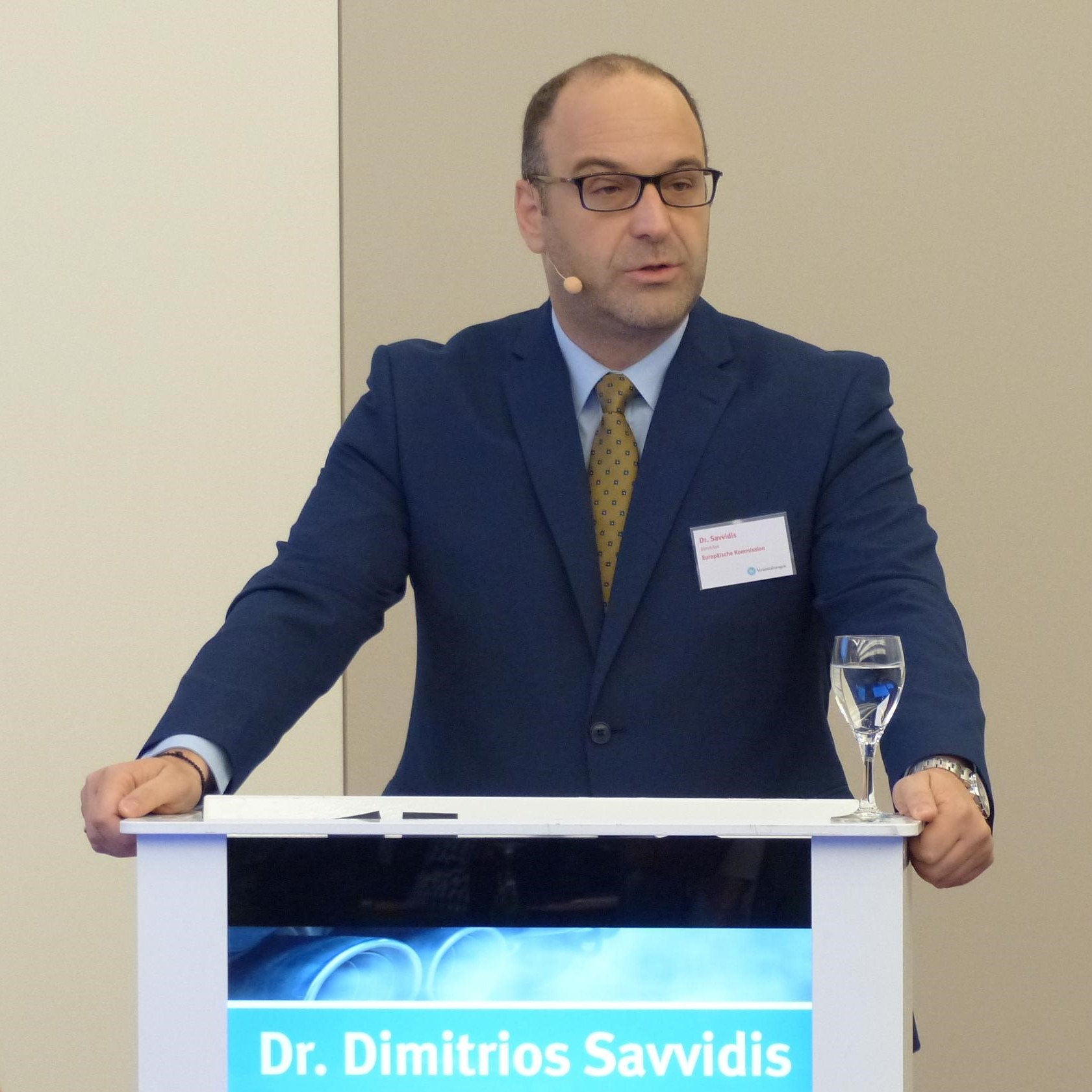Dr. Dimitrios K. Savvidis
Dr. Dimitrios Savvidis is currently employed by the the European Climate, Infrastructure and Environmental Executive Agency (CINEA) He is responsible for a portfolio Innovation Fund projects in the areas of road transport and hydrogen production/use. He performs tasks related to all stages of the project management cycle, from the evaluation of proposals, the preparation of grant agreements, the monitoring of projects, the assessment of technical and financial reports and reporting the feedback to policy-makers in the European Commission's DGs.

My CV
Research projects as scientific director
Research projects as a member of a core research team
- Preparation of mixtures of diesel and vegetable oils.
- Improvement of laboratory infrastructure and conversion of the Land Rover Jeep diesel engine to a gasoline engine.
- Measurement of physical and chemical properties of mixtures.
- Stable engine performance and exhaust mapping.
- Measurement of engine and exhaust gas efficiency by feeding the diesel engine with a mixture of diesel and cottonseed oil biodiesel.
- Measuring the engine and exhaust gas performance of a Land Rover Jeep diesel engine under road conditions.
- Measurement of engine and exhaust gas efficiency by feeding the diesel engine with a mixture of diesel and biodiesel from used vegetable cooking oils.
- Measurement
Educational programs as a speaker and/or team member
1.1 Teaching experience
Internal Combustion Engines – ICE
Development of engine technologies
Power measurements
Vehicle dynamics
* Internal Combustion Engines – ICE
* Development of engine technologies
* Energy efficient design of the powertrain and bodywork
* Green fuels (2st semester)
* Internal Combustion Engines – ICE
* Thermodynamics
* Internal Combustion Engines – ICE
* Automobile Computing Systems
* Fuelling systems * Mechanical applications
* Active and passive safety systems and methods
* Vehicle Engineering and Engineering
* Fuel lubricating liquids in vehicles
* Vehicle road behaviour
* Modern Diagnostic Methods
* Steering suspension braking systems
* Bodywork and superstructure technique
* Alternative forms of action
Teaching lessons:
* Internal Combustion Engines – ICE
* Thermodynamics
* Machine Details
* Conventional car technology
* New car technology
* Powertrains
* Steering suspension braking systems
* Vehicle pollution techniques
Teaching lessons:
* Internal Combustion Engines – ICE
* Automobile Computing Systems
* Powertrains
* Steering suspension braking systems
Internal Combustion Engines I – ICE I.
Internal Combustion Engines II – ICE II.
* Electrotechnical
* Vehicles II
* Engineering Laboratories – Vehicle data
* New MFN Design Methods
1.2 Lectures (with invitation)
* Keynote speaker and EU representative "VECTO and CO2 Emissions; Latest Developments in the Heavy Duty Vehicles’ Sector" in "4th Biennial International Conference on Powertrain Modelling and Control, Testing, Mapping and Calibration", Loughborough University, Loughborough, England, 10-11/9/2018.
* Keynote speaker and EU representative "CO2 emissions and fuel consumption from Heavy Duty Vehicles. What are the next steps in Europe?" in "5th International Conference Emission Reduction and Emission Sensors in the Automotive Industry", Mövenpick Airport Hotel, Stuttgart, Germany, 11-12/7/2018.
* Keynote speaker and host of the publication "CO2 emissions from Heavy Professional Vehicles in the European Union: Strategy and Regulatory Measures“ at the 39th International Engine Symposium in Vienna”, Hofburg Vienna Conference Centre, Vienna, Austria, 26-27/4/2018.
* Keynote speaker and EU representative at “Integer Emission Summit and AdBlue ® Asia-Pacific Forum”, Tokyo, Japan 14-15/3/2018.
* Speaker and EU representative at the technical workshop “IEA Expert Dialogue on Materials Trends in Transport”, Conference Centre de Ministeriel (CCM), 27 Rue de la Convention, Paris, France 8/3/2018.
* Speaker and EU representative at the “10th Integer Emission Summit and AdBlue ® China Forum 2017, Vehicle Transmission Strategies, Technologies and Debate”, Beijing, China, 16-18/5/2017.
* Speaker and EU representative at the conference “Trends in the Automotive Industry Industry 2017” on “The VECTO tool”, Munich, Germany, 27-28/4/2017.
* Speaker and EU representative at the Green Drive Project Conference "The vehicles of tomorrow: Challenges for industry and the University" on "The future of legislation on CO2 emissions and fuel consumption of Heavy Professional Vehicles in Europe", Antwerp, Belgium, 22-23/9/2016.
* Keynote speaker and EU representative at the “12th Integer Emission Summit and AdBlue ® Europe Forum 2016” on “The VECTO tool for measuring CO2 in commercial vehicles”, Brussels, Belgium, 21-23/6/2016.
* Keynote speaker and EU representative at the “14th CTI – Exhaust systems” on “Measuring CO2 emissions and fuel consumption of Heavy Professional Vehicles with the VECTO tool”, Frankfurt, Germany, 23-25/5/2016.
* Rapporteur at the training seminar of the Regional Education Directorate of Central Macedonia on “CO2 emissions from Heavy and Professional Vehicles”, 1 st EK Thessaloniki, Thessaloniki, 9/5/2016.
* Keynote speaker and EU representative at the “11th CTI International Conference” on “Measuring with VECTO CO2 emissions from Heavy Professional Vehicles – Policy Issues and Future Developments”, Stuttgart, Germany, 8-9/7/2015.
* Keynote speaker and EU representative at the “11th Integer Emission Summit and AdBlue ® Europe Forum 2015” on “VECTO information on CO2 measurement in commercial vehicles”, Brussels, Belgium, 16-18/6/2015.
* Keynote speaker and EU representative at the international workshop “Heavy Professional Vehicle Fuel Efficiency Regulations Meeting” with participants and representatives from China, Australia, Canada, India, Korea and Japan on “CO2 policy issues by Heavy Professional Vehicles in Europe and the VECTO tool”, New Delhi, India, 28-30/4/2015.
* Keynote speaker and EU representative at the conference “Logistics in the automotive industry – Conference of Europe 2015” on “CO2 policy issues from Heavy Professional Vehicles in Europe and the VECTO tool”, Bonn, Germany, 10-12/3/2015.
* Lecture at the Automotive Engineering Department of ATEI Thessaloniki on the subject of ‘The VECTO tool’, Thessaloniki TEI, Thessaloniki, Greece, 16/11/2014.
* Speaker and EU representative at the “17th UNECE Technical Working Meeting” on Hybrid Heavy Professional Vehicles – BEO, Madrid, Spain, 8-9/4/2014.
* Erasmus Energy efficient and Ecological Urban Transport Intensive Programme lecture on Current and Future Emission Limits for Cars – EcoDriving, Radom, Poland, 22/3/2014.
* Keynote speaker and EU representative at the technical workshop "Efficiency of Heavy Professional Vehicles: International Standards Harmonisation "with participants and representatives from China, the USA, Canada, Thailand, Korea and Japan on" European Union Certification Process, Review and Information ", Jiannin, China, 25-26/2/2014.
* Erasmus Energy efficient and Ecological Urban Transport Intensive Programme lecture at Kazimierz Pulaski University of Technology and Humanities in Radom on “Development of EU emission standards”, Radom, Poland, 4/4/2011.
* Erasmus intensive conferences “Ecology and Safety as Driving Forces in the Development of Vehicles” on “Recycling of materials and parts used on modern vehicles”, Turku, Finland, 17-19/3/2010.
* Postgraduate lectures “CarEcology”, Technical University of Wroclaw, Wroclaw, Poland, 1-10/3/2010.
* Lectures under the postgraduate programme “CarEcology” in “The combustion engine fuel systems” and “Exhaust gas after treatment technologies”, Universidad Politecnica de Valencia, Valencia, Spain, 3-11/11/2008.
* Lectures in Teaching Staff Mobility under the Socrates-Erasmus programme, Wroclaw University of Technology, Wroclaw, Poland, 10-15/1/2008.
* Rapporteur at the specialised seminar “Future pollutant emission limits and alternative fuels”, IEK DELTA, Thessaloniki, Greece, 19/3/2006.
1.3 Supervision of Master thesis
Έχουν αναφερθεί συνολικά 150 ετεροαναφορές (citations) στο συγγραφικό μου έργο (τελευταία ενημέρωση: Μάιος 2025) ενώ σύμφωνα με το Google Scholar και το ORCHID οι ετεροαναφορές είναι 401 με h-index 11 και i10-index 16 (Author ID: 14630829700, ORCID ID: 0000-0002-3018-3990 ). Στη λίστα ετεροαναφορών δεν περιλαμβάνονται οι αυτό- αναφορές (self-citations) καθώς και οι αναφορές συν-συγγραφέων (co-authors) από άρθρα και δημοσιεύσεις, που δεν είμαι συγγραφέας. Ακολουθεί η ανάλυση μερικών επιστημονικών εργασιών. Πλήρη περιγραφή όλων των εργασιών μπορεί να βρει κάποιος στο “Βιογραφικό Σημείωμα & Υπόμνημα Ερευνητικού – Διδακτικού Έργου”.
Dimitrios Savvidis, "Εκπομπές ρύπων από κινητήρες μέσων μεταφοράς σε πραγματικές συνθήκες", PhD in Road Transport Emissions in the Real World, School of Process, Environmental and Materials Engineering - SPEME, The University of Leeds, Μάιος 2011.
Στόχος των δοκιμών και μετρήσεων που παρουσιάζονται στη διατριβή αυτή ήταν η ανάλυση και μελέτη τόσο των νομοθετημένων όσο και των μη-νομοθετημένων εκπομπών ρύπων τεσσάρων οχημάτων για διαφορετικούς κύκλους οδήγησης. Επιβατικά βενζινοκίνητα οχήματα, συμβατά με τα πρότυπα εκπομπών EURO 1-4 συγκρίθηκαν μεταξύ τους σχετικά με τις εκπομπές ρύπων υπό πραγματικές συνθήκες. Μελετήθηκε η επίδραση στο ρυθμό αύξησης της θερμοκρασίας του κινητήρα αλλά και στις εκπομπές καυσαερίων των διαφορετικών θερμοκρασιών περιβάλλοντος σε δοκιμές που έγιναν όχι μόνο καλοκαίρι αλλά και χειμώνα. Να επισημανθεί ότι παρατηρήθηκε μεγαλύτερη επίδραση των θερμοκρασιών περιβάλλοντος στο ρυθμό αύξησης της θερμοκρασίας του λιπαντικού μέσου και του ψυκτικού υγρού απ' ότι στη θερμοκρασία λειτουργίας του καταλύτη μέχρι να επιτύχει το μέγιστο βαθμό απόδοσης. Αναπτύχθηκαν και χρησιμοποιήθηκαν πέντε διαφορετικοί αστικοί κύκλοι οδήγησης που περιελάμβαναν οδήγηση ελεύθερης ροής και οδήγηση με συμφόρηση. Μετρήθηκαν και συγκρίθηκαν με τη σχετική νομοθεσία της ΕΕ οι εκπομπές καυσαερίων υπό πραγματικές συνθήκες οδήγησης σε αστικό περιβάλλον χρησιμοποιώντας το σύστημα μέτρησης εκπομπών FTIR (Fourier Transform Infra-Red) που τοποθετήθηκε στα οχήματα. Διαφορετικές παράμετροι οδήγησης όπως η ταχύτητα, η κατανάλωση καυσίμου και ο λόγος αέρα/καυσίμου, οι θερμοκρασίες του ψυκτικού υγρού, του λιπαντικού μέσου και των καυσαερίων καταγράφηκαν και αναλύθηκαν για όλους τους παραπάνω κύκλους οδήγησης. Διερευνήθηκε και αξιολογήθηκε το προφίλ της θερμοκρασίας που υποδεικνύει την απαιτούμενη χρονική περίοδο για την μέγιστη απόδοση του καταλύτη αλλά και η επίδραση της ψυχρής εκκίνησης στην κατανάλωση καυσίμου. Εκτός από τις εκπομπές των CO 2 , CO, HC και NOx αναλύθηκαν επίσης οι εκπομπές των πτητικών οργανικών ενώσεων (VOC - Volatile Organic Compounds) και υπολογίστηκε το δυναμικό σχηματισμού όζοντος (OFP - Ozone Formation Potential) σε μεγάλες αστικές οδούς και διασταυρώσεις για διαφορετικά αυτοκίνητα. Υπολογίστηκαν επίσης, ως συνάρτηση του ρυθμού θέρμανσης του κινητήρα και των κύκλων οδήγησης, διάφορα αέρια του θερμοκηπίου, όπως CO 2 , N 2 O και συνακόλουθα το δυναμικό παγκόσμιας θέρμανσης (GWP - Global Warming Potential) και οι εκπομπές CH 4 . Τα αποτελέσματα είχαν μια λογική επαναληψιμότητα στις περισσότερες εκπομπές ρύπων και παρείχαν καλύτερη κατανόηση των εκπομπών αεριών του θερμοκηπίου που συνδέονται με την κυκλοφοριακή συμφόρηση στις αστικές περιοχές και θα συμβάλουν στον έλεγχο της κλιματικής αλλαγής. Αυτή η έρευνα ανέλυσε το στοιχεία που επηρεάζουν τις εκπομπές καυσαερίων εντός πόλης και θα είναι χρήσιμη για την καλύτερη διαχείριση του κυκλοφοριακού και τη μείωση των εκπομπών ρύπων. Τα στοιχεία της έρευνας μπορούν να χρησιμοποιηθούν για την πρόβλεψη των εκπομπών ρύπων στις αστικές περιοχές.
Δημήτριος Σαββίδης, "Σύγχρονα συστήματα πέδησης και ασφάλεια", Εκδοτικός Οίκος Γκιούρδα, (πρώτη έκδοση), ISBN 960-630-763-8, Θεσσαλονίκη, Ελλάδα, Νοέμβριος 2006.
Στο βιβλίο αυτό περιέχονται πληροφορίες για τα συστήματα πέδησης των οχημάτων και των διαφόρων εξαρτημάτων που χρησιμοποιούνται σήμερα, ενώ μελετάται και η αρχή λειτουργίας του συστήματος ABS με έμφαση στις διάφορες παραλλαγές που κυκλοφορούν στην αγορά. Αναλύεται και περιγράφεται λεπτομερώς ο τρόπος λειτουργίας του συστήματος ελέγχου ολίσθησης των τροχών ενός οχήματος, ενώ γίνεται μελέτη της επίδρασης των χαρακτηριστικών του συστήματος πεδήσεως στην οδική συμπεριφορά του οχήματος. Καλύπτονται ενότητες όπως οι ηλεκτρικοί και υδραυλικοί επιβραδυντές (retarders) ενώ τέλος, γίνεται μια αναφορά στη διαδικασία έγκρισης τύπου ενός συστήματος πέδησης και τη νομοθεσία που πρέπει να καλύπτει αυτό, από το αρχικό στάδιο της σχεδίασης μέχρι την τοποθέτησή του στα σύγχρονα οχήματα
Georgios Fontaras, Theodoros Grigoratos, Dimitrios Savvidis, Konstantinos Anagnostopoulos, Raphael Luz, Martin Rexeis, Stefan Hausberger, "An experimental evaluation of the methodology proposed for the monitoring and certification of CO 2 emissions from heavy-duty vehicles in Europe", Elsevier Energy Volume 102, 1 May 2016, Pages 354–364, doi: 10.1016/j.energy.2016.02.076.
Στην εργασία αυτή γίνεται μια αξιολόγηση της μεθοδολογίας που προτάθηκε από την Ευρωπαϊκή Επιτροπή για την παρακολούθηση και την πιστοποίηση των εκπομπών CO 2 και της κατανάλωσης καυσίμου των βαρέων οχημάτων (φορτηγά και λεωφορεία) στην Ευρώπη. Η νέα μεθοδολογία βασίζεται σε ένα συνδυασμό από δοκιμές εξαρτημάτων και υπολογιστική προσομοίωση της κατανάλωσης καυσίμου των οχημάτων. Μετρήσεις διεξήχθησαν σε δύο οχήματα, έναν ελκυστήρα (τράκτορα) 40t Euro VI μεγάλων αποστάσεων και ένα 18t Euro V φορτηγό με δύο άξονες. Οι μετρήσεις πραγματοποιήθηκαν τόσο σε δυναμόμετρο πέδης όσο και σε πραγματικές συνθήκες στο δρόμο. Ένα λογισμικό προσομοίωσης χρησιμοποιήθηκε για την προσομοίωση των δοκιμών. Η ικανότητα του λογισμικού να καταγράφει την απόδοση του οχήματος και την κατανάλωση καυσίμου αξιολογήθηκε με βάση τα δεδομένα που μετρήθηκαν. Τα αποτελέσματα της προσομοίωσης είναι πολύ κοντά με εκείνα των δοκιμών επί του δυναμομέτρου ενώ η τελική τιμή προσομοίωσης της κατανάλωσης καυσίμου αποκλίνει κατά περίπου ±2-4% σε σύγκριση με τις μετρηθείσες τιμές. Κατά τη διάρκεια των δοκιμών που πραγματοποιήθηκαν στο δρόμο, η τελική κατανάλωση καυσίμου παρουσίασε μια απόκλιση ±3,5% από αυτή της προσομοίωσης και συνάγεται το συμπέρασμα ότι ένα μελλοντικό σύστημα πιστοποίησης του οχήματος μπορεί να βασιστεί σε αυτή την προσέγγιση και να επιτύχει υψηλή αντιπροσωπευτικότητα, σε σύγκριση
Pierre Bonnel, Adolfo Perujo, Alessio Provenza, Pablo Mendoza Villafuerte in collaboration with Dimitriοs Savvidis, "Non Road Engines Conformity Testing Based on PEMS", JRC Scientific and Policy Reports, Report EUR 26438 EN, ISBN 978-92-79- 35090-0, doi: 10.2789/18679, Luxembourg: Publications Office of the European Union, 2013
Με την εισαγωγή των προτύπων EURO V για τους κινητήρες βαρέως τύπου, η Ευρωπαϊκή νομοθεσία για τις εκπομπές καυσαερίων απαιτεί την επαλήθευση της συμμόρφωσης των κινητήρων βαρέως τύπου με τα ισχύοντα πρότυπα πιστοποίησης εκπομπών: οι εν λόγω διατάξεις ορίζονται ως "Συμμόρφωση εν λειτουργία" (In Service Conformity - ISC). Θεωρήθηκε ανέφικτη και δαπανηρή η υιοθέτηση συστήματος ISC για τα βαρέα επαγγελματικά οχήματα που απαιτεί την απομάκρυνση του κινητήρα από τα οχήματα για τη δοκιμή εκπομπών ρύπων σε σχέση με τα νομοθετικά όρια. Ως εκ τούτου, προτάθηκε να αναπτυχθεί ένα πρωτόκολλο για τον έλεγχο της συμμόρφωσης εν λειτουργία των βαρέων επαγγελματικών οχημάτων βάσει της χρήσης των φορητών συστημάτων μέτρησης εκπομπών (Portable Emission Measurement Systems - PEMS). Ως αποτέλεσμα, η δοκιμή ISC με βάση τα PEMS εισήχθη στα πρότυπα EURO V και EURO VI. Οι αντίστοιχες διοικητικές και τεχνικές διατάξεις διατυπώθηκαν στους Ευρωπαϊκούς κανονισμούς 582/2011 και 64/2012. Η παραπάνω πορεία ακολουθήθηκε και για τους κινητήρες των μη οδικών κινητών μηχανημάτων (Non Road Mobile Machinery - NRMM): οι προκαταρκτικές ερευνητικές δραστηριότητες μελετήθηκαν και επιβεβαίωσαν τη δυνατότητα εφαρμογής των μεθόδων που έχουν αναπτυχθεί για κινητήρες βαρέως τύπου με μικρές τροποποιήσεις. Η βάση για την εισαγωγή των διατάξεων ISC βάσει της προσέγγισης PEMS στην ευρωπαϊκή νομοθεσία για την έγκριση τύπου των NRMM έχει επιβεβαιωθεί σε πολλά κείμενα. Το πιλοτικό πρόγραμμα "NRMM PEMS" ξεκίνησε για να διευκολυνθεί η εισαγωγή στην ευρωπαϊκή νομοθεσία για τις εκπομπές των NRMM της χρήσης των PEMS ως εργαλείου για την ISC. Αυτό έπρεπε να επιτευχθεί με τη βελτίωση των τεχνικών διαδικασιών (π.χ. διαθέσιμο από το πρόγραμμα των βαρέων οχημάτων) και την αύξηση της ευαισθητοποίησης των διαφόρων φορέων σχετικά με τα PEMS ως νέο νομοθετικό εργαλείο.
D. Savvidis, K. Bounos, B. Sochacki and C. Ioakimidis, "Engine emissions measurements from passenger cars at two different locations within the metropolitan area of Antwerp in Belgium and further statistical analysis", Internal Combustion Engines: Performance, Fuel Economy and Emissions, IMechE Combustion Engines and Fuels Group Conference, London, England, 27-28 November 2013: 67-77, ISBN: 9781782421849. Woodhead Publishing.
Η εργασία παρουσιάζει πραγματικές μετρήσεις εκπομπών καυσαερίων από κινητήρες επιβατικών αυτοκινήτων (βενζίνης και πετρελαίου) σε δύο διαφορετικές τοποθεσίες της πανεπιστημιούπολης του Πανεπιστημίου της Αμβέρσας εντός της μητροπολιτικής περιοχής της Αμβέρσας στο Βέλγιο. Τα περισσότερα από τα οχήματα μετρήθηκαν υπό διάφορες συνθήκες λειτουργίας (ζεστός ή κρύος κινητήρας) και υπό διάφορες καιρικές συνθήκες (διαφορετική θερμοκρασία περιβάλλοντος, υγρασία κ.λπ.). Πολύ χαμηλές θερμοκρασίες, καιρικές συνθήκες με χιόνι ή βροχερές και ηλιόλουστες μέρες συμπεριλήφθηκαν και ελήφθησαν υπόψη στις μετρήσεις και οι διαφορές στις εκπομπές καυσαερίων παρουσιάζονται στη συγκεκριμένη εργασία.
Li H., Andrews G.E. and Savvidis D., "Influence of Cold Start and Ambient Temperatures on Greenhouse Gas (GHG) Emissions, Global Warming Potential (GWP) and Fuel Economy for SI Car Real World Driving", SAE Int. J. Fuels Lubs. 3(1): 133-148, 2010. (SAE Technical Paper Series 2010-01-0477. SAE Book SP-2292: Advances in Alternative Energy and Fuels for the Transportation Sector, 2010. ISBN: 978-0-7680- 3426-4. SAE World Congress, Detroit, USA).
Αυτή η εργασία διερεύνησε τρία από τα αέρια του θερμοκηπίου που εκπέμπονται από τις οδικές μεταφορές με τη χρήση ενός βενζινοκίνητου EURO 2 επιβατηγού οχήματος: Συγκεκριμένα αξιολογήθηκαν οι εκπομπές CO 2 , N 2 O και CH 4 ως συνάρτηση της ψυχρής εκκίνησης του οχήματος και της θερμοκρασίας περιβάλλοντος. Ένας κύκλος δοκιμής σε πραγματικές συνθήκες έχει αναπτυχθεί στο Λιντς και αναφέρεται ως LU-BS, ο οποίος έχει αστικό πρότυπο οδήγησης ελεύθερης ροής. Το όχημα δοκιμής οδηγήθηκε στην ίδια διαδρομή από τον ίδιο οδηγό σε διαφορετικές ημέρες με διαφορετικές θερμοκρασίες περιβάλλοντος. Όλες οι δοκιμές ξεκίνησαν με κρύα εκκίνηση. Ένα σύστημα μέτρησης εκπομπών καυσαερίων τύπου FTIR (Fourier Transform Infra-Red) με ακρίβεια 0,5 Hz τοποθετήθηκε εντός του οχήματος για τις μετρήσεις. Αυτό το σύστημα μέτρησης εκπομπών βαθμονομήθηκε σε ένα πρότυπο σύστημα μέτρησης CVS και διαπιστώθηκε εξαιρετική ακρίβεια μεταξύ των μετρήσεων CO 2 με τα αποτελέσματα του CVS (Constant Volume Sampling). Τα N 2 O και CH 4 βαθμονομήθηκαν με φιάλες αερίου βαθμονόμησης. Η επίδραση της θερμοκρασίας περιβάλλοντος στα αέρια του θερμοκηπίου και στο δυναμικό θέρμανσης του πλανήτη (GWP) επίσης αξιολογήθηκαν στη συγκεκριμένη εργασία. Η έρευνα βοήθησε στην καλύτερη κατανόηση της επίδρασης του κυκλοφοριακού στα αέρια του θερμοκηπίου σε αστική περιοχή και θα συνεισφέρει στον έλεγχο της κλιματικής αλλαγής.











